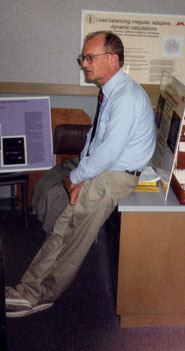
Spring/Summer 1999
Volume 6, Issue 2
Spring/Summer 1998
Volume
3, Issue 1
January 1995
Volume
2, Issue 4
October 1994
Volume
2, Issue 1
January 1994
CalTech Workshop Exposes Teachers to New Computing Developments
At CalTech this summer, 19 Los Angeles-area teachers from high schools and middle schools with large minority enrollments attended the eighth Minorities Teachers Computational Sciences Awareness Program. Held June 23-27, the workshop introduced these teachers to the most recent developments and opportunities in concurrent computing. The participants will use this information to motivate their students to consider career opportunities in science and engineering.
This year's participants were exposed to the cutting edge of these fields through presentations, demos, hands-on applications, and discussions with some of the world's leaders in new areas of concurrent computing, biotechnology, computer graphics, and their applications and interrelationships.
 |
"It was great to find out what's going on in the research community," says Debora Blais, a math teacher at Alhambra High School. "Being sheltered in the classroom on a daily basis, we don't have the time or opportunity to keep up with the latest activities and share them with our students."
"I enjoyed learning and reviewing how computational sciences are used to facilitate advanced research studies," adds Colette Barris, a computer science/ physical science teacher at Wilson Middle School. "I look forward to the process of creating a way to introduce and implement computational science at the middle school level."
For more information on the Minorities Teachers Computational Sciences Awareness Program, contact JoAnn Boyd at CalTech, joann@cscr.caltech.edu . For information on the Scientific Simulation Cluster Computer Project, see http://oscar.cacr.caltech.edu/Hrothgar/DD/.
Table of Contents